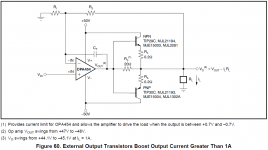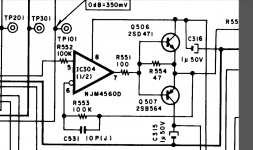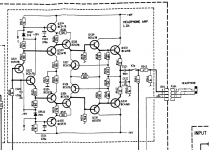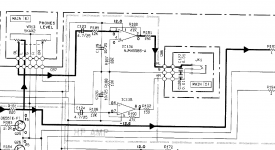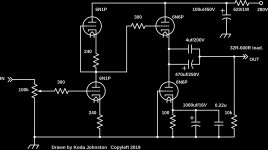If ska-150 is not simple i wonder what's simpler at that kind of power except zeta 2...
for instance any schematic i am attaching ... Like the one i am attaching below ... that is simple 🙂
like the last one of the Nikko Alpha III recommended by one of the member of the design team at the times as one of the best sounding in the Nikko production (as an aside i had a alpha II ... one channel was not working properly because badly repaired ... but the one working fine was emitting a good sound. The Alpha III is much simpler design and supposedly sounds even better).
That amp that has changed completely my belief on op-amps And the opamp used it is very old.
Attachments
Last edited:
Only if you're not careful... This torch is overkill, but you get the idea
i see. I think i will try again braid with a big tip iron. That should work
The dreadful simple amplifier where it is believed that feedback can fix any distortion.for instance any schematic i am attaching ... Like the one i am attaching below ... that is simple 🙂
like the last one of the Nikko Alpha III recommended by one of the member of the design team at the times as one of the best sounding in the Nikko production (as an aside i had a alpha II ... one channel was not working properly because badly repaired ... but the one working fine was emitting a good sound. The Alpha III is much simpler design and supposedly sounds even better).
That amp that has changed completely my belief on op-amps And the opamp used it is very old.
Here, it will not remove humongous crossover distortion.
The dreadful simple amplifier where it is believed that feedback can fix any distortion.
Here, it will not remove humongous crossover distortion.
I see. Therefore you exclude that it can sound really good ? actually it is not become a classic ... 😱
The trick with using braid is to use a hot iron for a shorter time. I set my iron to at least 380c.i see. I think i will try again braid with a big tip iron. That should work
I use this tip American Hakko Products, Inc. T15-D24 for doing the initial desoldering/wicking and then I also use a pinpoint tip American Hakko Products, Inc. T15-ILS for clearing holes on PCBs (I stab it through the braid) so I can get the new parts into the holes...
Last edited:
i have no clue. What i know is that the designer was telling that measurements were important at the time. So i guess it must have been low in noise and distortion and high in slew rateHow does it sound with harmonics 3,5,7,9,11,13,15,17,19,21 ?
The trick with using braid is to use a hot iron for a shorter time. I set my iron to at least 380c. I also use a pinpoint tip for clearing holes on PCBs (I stab it through the braid) so I can get the new parts into the holes...
This tip in particular. American Hakko Products, Inc. T15-ILS
Thanks for the very useful advice. I tried braid but with little success 🙁
I had this one in the video
Improving a cheap vacuum desolder-station (ZD-915) - YouTube
was ok
You're welcome.
For really stubborn parts, I've even used something like this - I only use a torch when I don't care about the board the parts are on - salvage:

Also, For what it's worth, I use superwick.
The hint about high temperature is right in the description: "No-Clean Super Wick™ is a tightly woven, oxide-free copper braid coated with a high activation temperature no-clean flux. Its high purity and tight weave make it fast-wicking, quickly removing solder and minimizing dwell time."
https://www.mgchemicals.com/product.../desoldering-braids/no-clean-super-wick-400ns
For really stubborn parts, I've even used something like this - I only use a torch when I don't care about the board the parts are on - salvage:

Also, For what it's worth, I use superwick.
The hint about high temperature is right in the description: "No-Clean Super Wick™ is a tightly woven, oxide-free copper braid coated with a high activation temperature no-clean flux. Its high purity and tight weave make it fast-wicking, quickly removing solder and minimizing dwell time."
https://www.mgchemicals.com/product.../desoldering-braids/no-clean-super-wick-400ns
Last edited:
Look my friend! here's the Nakamichi Dragon headphones amplifier.Although a Nakamichi classic this was the worst ever sounding thing made by Nakamichi but it was only used for monitoring the recording level.Everybody else is using the line out for listening...I see. Therefore you exclude that it can sound really good ? actually it is not become a classic ... 😱
If you really want a good headphone amplifier Tandberg 3014 is the one.if you're curious about the prodigy child upstairs, go with Yamaha kx930 opamp variation.If you really want to know waht professionals use go with Studer A820 who's headphones amp is the industry standard.
Attachments
Wow... 14 active devices instead of the 4 I use... I wonder how the two circuits actually compare in real life? The OP of this thread: Any very good sounding tube headphone amp ideas ? seems to really like it a lot even though they are running lowZ phones and as said it's current limited.
My output is current limited to 20mA... Fine for highZ, fine for lowZ at lowVolume. Oh, and it's single ended.
My output is current limited to 20mA... Fine for highZ, fine for lowZ at lowVolume. Oh, and it's single ended.
Attachments
Last edited:
I think you're looking to advertise your tube schematics and here's not the place.There are lots of simpler headphones amp based on tubes than yours .
I don't sell these commercially unless it's a "one off". I spread good designs on the net and other people are free to use them and adapt them as they see fit. Not sure where your use of the term "advertise" is coming from. I'm posting things I built through trial and error and found to be good designs, and I offer them FOR FREE to anyone who wants to use them, and in comparison to a 14 device transistor amp ripped from a commercial schematic (that YOU said was crap). I truly wonder which sounds better but I think I already know the answer. Please offer a circuit you designed though. I'd be very interested.
Last edited:
You do avertise your designs!
And the simplest headphones amp with valves can be done with only one single valve and an output transformer , no need for SRPP and cathode followers.
And the simplest headphones amp with valves can be done with only one single valve and an output transformer , no need for SRPP and cathode followers.
Really? Link an ad. I'll wait.
None of that design uses an SRPP. I suggest you read up on what makes SRPP work... There is ZERO push pull action in this circuit - it is entirely single ended. The first stage is common cathode coupled to a cathode follower... Both have "active loads".
You CAN use a single tube with a transformer, but this sounds better and costs less.
None of that design uses an SRPP. I suggest you read up on what makes SRPP work... There is ZERO push pull action in this circuit - it is entirely single ended. The first stage is common cathode coupled to a cathode follower... Both have "active loads".
You CAN use a single tube with a transformer, but this sounds better and costs less.
i have no clue. What i know is that the designer was telling that measurements were important at the time. So i guess it must have been low in noise and distortion and high in slew rate
It can only be terrible in distortion.
It is very easy to simulate with LTSpice and see the harmonics displayed by the FFT and the THD figure given by the .four directive.
whatever...i can't lose my time analysing yor designs in depth...i don't care about them. I didn't populate this topic with my owns trying to get attraction for that.If you need more attention for your things go get it on your topics! We got your point!Really? Link an ad. I'll wait.
None of that design uses an SRPP. I suggest you read up on what makes SRPP work... There is ZERO push pull action in this circuit - it is entirely single ended. The first stage is common cathode coupled to a cathode follower... Both have "active loads".
You CAN use a single tube with a transformer, but this sounds better and costs less.
That's fair of you to say, even if it was dismissive.. Tube circuitry isn't for everyone.
Remember though, this is a public forum, and many other people will find this. Some of which will find this useful.
As I said before, I simply add my ideas to the mix. Especially for those who've never used tubes but grew up with transistors (the opposite of my experience). Simple, easy to build ideas that work well every time.
Remember though, this is a public forum, and many other people will find this. Some of which will find this useful.
As I said before, I simply add my ideas to the mix. Especially for those who've never used tubes but grew up with transistors (the opposite of my experience). Simple, easy to build ideas that work well every time.
- Home
- Member Areas
- The Lounge
- Overengineering in audio equipment
